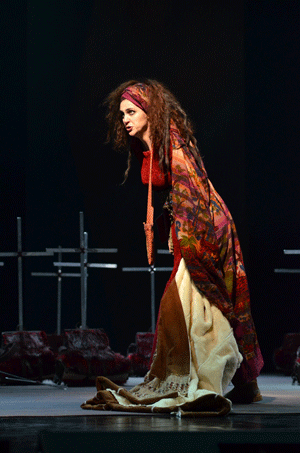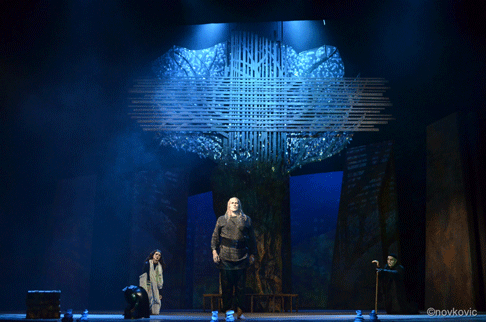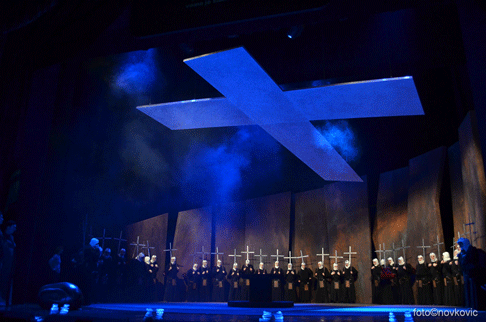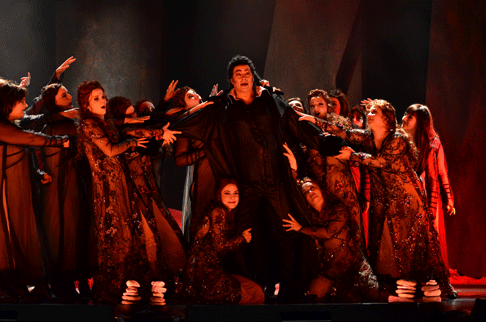![John Charles Pierce as Parsifal and Dubravka Šeparović Mušović as Kundry [Photo by S. Novković courtesy of Hrvatskoga Narodnog Kazališta U Zagrebu]](http://www.operatoday.com/Parsifal_Zagreb_01.gif)
26 Apr 2012
Zagreb’s Wagner Casts Its Spell
Croatian National Opera, in collaboration with Würzburg’s (Germany) Mainfranken Theater has made quite a forceful case for Parsifal.
English Touring Opera are delighted to announce a season of lyric monodramas to tour nationally from October to December. The season features music for solo singer and piano by Argento, Britten, Tippett and Shostakovich with a bold and inventive approach to making opera during social distancing.
This tenth of ten Live from London concerts was in fact a recorded live performance from California. It was no less enjoyable for that, and it was also uplifting to learn that this wasn’t in fact the ‘last’ LfL event that we will be able to enjoy, courtesy of VOCES8 and their fellow vocal ensembles (more below …).
Ever since Wigmore Hall announced their superb series of autumn concerts, all streamed live and available free of charge, I’d been looking forward to this song recital by Ian Bostridge and Imogen Cooper.
Although Stile Antico’s programme article for their Live from London recital introduced their selection from the many treasures of the English Renaissance in the context of the theological debates and upheavals of the Tudor and Elizabethan years, their performance was more evocative of private chamber music than of public liturgy.
Evidently, face masks don’t stifle appreciative “Bravo!”s. And, reducing audience numbers doesn’t lower the volume of such acclamations. For, the audience at Wigmore Hall gave soprano Elizabeth Llewellyn and pianist Simon Lepper a greatly deserved warm reception and hearty response following this lunchtime recital of late-Romantic song.
For this week’s Live from London vocal recital we moved from the home of VOCES8, St Anne and St Agnes in the City of London, to Kings Place, where The Sixteen - who have been associate artists at the venue for some time - presented a programme of music and words bound together by the theme of ‘reflection’.
'Such is your divine Disposation that both you excellently understand, and royally entertaine the Exercise of Musicke.’
‘And there was war in heaven: Michael and his angels fought against the dragon; and the dragon fought and his angels, And prevailed not; neither was their place found any more in heaven … that old serpent … Satan, which deceiveth the whole world: he was cast out into the earth, and his angels were cast out with him.’
There was never any doubt that the fifth of the twelve Met Stars Live in Concert broadcasts was going to be a palpably intense and vivid event, as well as a musically stunning and theatrically enervating experience.
‘Love’ was the theme for this Live from London performance by Apollo5. Given the complexity and diversity of that human emotion, and Apollo5’s reputation for versatility and diverse repertoire, ranging from Renaissance choral music to jazz, from contemporary classical works to popular song, it was no surprise that their programme spanned 500 years and several musical styles.
The Academy of St Martin in the Fields have titled their autumn series of eight concerts - which are taking place at 5pm and 7.30pm on two Saturdays each month at their home venue in Trafalgar Square, and being filmed for streaming the following Thursday - ‘re:connect’.
The London Symphony Orchestra opened their Autumn 2020 season with a homage to Oliver Knussen, who died at the age of 66 in July 2018. The programme traced a national musical lineage through the twentieth century, from Britten to Knussen, on to Mark-Anthony Turnage, and entwining the LSO and Rattle too.
With the Live from London digital vocal festival entering the second half of the series, the festival’s host, VOCES8, returned to their home at St Annes and St Agnes in the City of London to present a sequence of ‘Choral Dances’ - vocal music inspired by dance, embracing diverse genres from the Renaissance madrigal to swing jazz.
Just a few unison string wriggles from the opening of Mozart’s overture to Le nozze di Figaro are enough to make any opera-lover perch on the edge of their seat, in excited anticipation of the drama in music to come, so there could be no other curtain-raiser for this Gala Concert at the Royal Opera House, the latest instalment from ‘their House’ to ‘our houses’.
"Before the ending of the day, creator of all things, we pray that, with your accustomed mercy, you may watch over us."
The doors at The Metropolitan Opera will not open to live audiences until 2021 at the earliest, and the likelihood of normal operatic life resuming in cities around the world looks but a distant dream at present. But, while we may not be invited from our homes into the opera house for some time yet, with its free daily screenings of past productions and its pay-per-view Met Stars Live in Concert series, the Met continues to bring opera into our homes.
Music-making at this year’s Grange Festival Opera may have fallen silent in June and July, but the country house and extensive grounds of The Grange provided an ideal setting for a weekend of twelve specially conceived ‘promenade’ performances encompassing music and dance.
There’s a “slide of harmony” and “all the bones leave your body at that moment and you collapse to the floor, it’s so extraordinary.”
“Music for a while, shall all your cares beguile.”
The hum of bees rising from myriad scented blooms; gentle strains of birdsong; the cheerful chatter of picnickers beside a still lake; decorous thwacks of leather on willow; song and music floating through the warm evening air.
![John Charles Pierce as Parsifal and Dubravka Šeparović Mušović as Kundry [Photo by S. Novković courtesy of Hrvatskoga Narodnog Kazališta U Zagrebu]](http://www.operatoday.com/Parsifal_Zagreb_01.gif)
Croatian National Opera, in collaboration with Würzburg’s (Germany) Mainfranken Theater has made quite a forceful case for Parsifal.
They have accomplished this first and foremost by assembling a cast of superlative singers, with pride of place going to the intriguing Kundry as impersonated by Dubravka Šeparović Mušović. She is an artist of great imagination and infinite variety. In Act One, she is a displaced street person, in Two a glamorous seductress who seems on the verge of a nervous breakdown as she vacillates between being Klingsor’s willing accomplice and a penitent in search of redemption. Free-wheeling moments of unbridled lust give way to nervous, guilty tics and stomach-churning disgust (for the character, not us). This was a valid, fully engaged, undeniably schizophrenic take on the character and Ms. Mušović wholly owned it.
 Dubravka Šeparović Mušović as Kundry
Dubravka Šeparović Mušović as Kundry
Nor did she stint in the vocal arena as she let loose with an awesome arsenal of well-calculated effects including a smoldering low voice, searing top, well knit registers, tenderly caressed phrasings, and superbly controlled dynamics, remarkably all of a piece. There was not a moment that she was not invested in the emotional truth of Kundry’s musical lines as she fully immersed herself in a highly personal traversal of one of opera’s most complex characters.
Anton Keremidchiev served up a commanding Klinsgor possessed of what was easily the most beautiful voice I have ever heard cast in this part. Instead of the usual muscled up ranting and bluster, here was a clean, penetrating instrument deployed with a commendable sense of line and dramatic purpose. No parking, no barking, just forcefully beautiful vocalizing.
Veteran Claudius Muth showed off an orotund bass as Gurnemanz, utilized with a keen understanding of his well-schooled technique. The low and middle range rolled out with an easy presence, and while the very highest notes are just outside his core comfort zone, Mr. Muth managed them with consummate skill. Davor Radić contributed a ringing, secure account of Amfortas. Perhaps a tad too secure since his solid, pointed baritone rarely dipped in volume much below forte. A bit of modulation and color would enhance his somewhat stentorian presentation of the suffering soul.
Ivica Trubić likewise intoned a solid, off-stage Titurel, although it was a bit hard to judge any nuance in his vocals since they were amplified with a good deal of reverb. The excellent Flower Maidens were the best matched, most vibrant, and thrillingly sung of any in my experience.
 John Charles Pierce as Parsifal, Dubravka Šeparović Mušović as Kundry and Manfred Hemm as Gurnemanz
John Charles Pierce as Parsifal, Dubravka Šeparović Mušović as Kundry and Manfred Hemm as Gurnemanz
That leaves our hero, and John Charles Pierce did not disappoint in the title role. I admit it, I am spoiled. My first Parsifal ever was Jon Vickers, who probably wrecked me for others forever. Mr. Pierce brought complete understanding to bear, and has a pleasant stage manner and a far more than serviceable tenor. Although he seems to cover the sound a bit, when he goes to nail a high phrase, he is able to summon a laser-like clarity. He was never less than thoroughly competent, and often brought joy, but he never quite elevated the role enough to make me forget that his is arguably the least interesting role in the opera.
Conductor Saša Britvić worked musical wonders in the pit helming this musical monster-piece. Predictably, the orchestra fared at its most virtuosic best in the more fiery Act Two, which bubbles and churns along more vividly. In the cruelly demanding expanses of One and Three, the group strove to much good effect in knitting the long, drawn out amblings into a unified whole. There were a few lapses of rhythmic impulse as the piece languidly unfolds (especially in the long rests which sapped the forward motion) and there was a slight dip in accurate intonation ‘round about the 100th minute of Act One, but overall, Maestro Britvić and his players should be duly proud of their achievement. The chorus, too, was trained to a fare-thee-well, and frequently raised goose bumps with their dynamic, poised singing.
To say the production recalls the best of the 1950’s is not to denigrate it in any way. In a nod to Wieland, designer Rudolf Rischer’s basic concept is a circle of Stonehenge-like monoliths that not only revolve at times to interesting new configurations, but also accept all manner of meaningful lighting gobo projections, such as stars, waves, etc. Within this milieu, the addition of a huge, tilted white cross, or the addition of a bridge skirted by red drapes provide all that is needed to adequately communicate Wagner’s intentions.
Gera Graf’s well-considered costumes are also rather timeless, offering a decidedly contemporary twist on the period. Flower maidens burst through the slit red drapes first demurely clad in white nun garb, with the wimples but minus the veils, then change and reappear in glittery, sequined, flesh-colored gowns. The knights are in generic tunics and cowls emblazoned with crosses, each with a sort of red-velvet back-pack that has a metal cross stuck upright in it. These get removed and positioned inventively about the stage, and the crosses later get extracted, upended, and brandished as swords.
 Scene from Parsifal
Scene from Parsifal
Parsifal is all ‘Heroic Montsalvat Man-in-Black’ and sports a wondrous wig of dreadlocks. Indeed all of the hair treatment was quite inspired, and the make-up plot was of the kind you never see anymore, meant to convey features all the way to the top row of the balcony. Kundry’s genial hippie bag lady attire of One yielded to the second act's generic black gown as she was first unfurled, moaning and blindfolded, out of a cocoon of a red carpet. Soon enough, she was got up in a form-fitting black number with an extravagant blond wig, the whole effect topped with a massive “dust cover” of white chiffon. This piece of cloth gets put to creative dramatic use and gets re-purposed any number of times, not least of which as an ersatz spider web.
Roger Vanoni’s lighting design was effectively varied and gloriously colorful. Best of all, the singers faces were (almost) always fully lit. How cool is that? (Or ‘hot’?) A single caveat is that one of the follow-spot operators needs a brush-up in technique. Either Parsifal was being too spontaneous in his Act Two peregrinations or the operator was inattentive or both, for the light was too often playing catch-up to the actor. The concept that Klingsor was clad in a red suit (a la the Devil in Jerry Springer — The Opera) and operated Vari-lights from a sort of DJ desk on the suspended bridge was a fun conceit. When 'Special K' commanded a disco display of flashing lights, it somehow made sense and underscored his control freak persona.
Director Kurt Josef Schildknecht has invested good intentions in his stage pictures and has created plausible relationships between his characters. There is sometimes a tendency to sing forward for implausibly long stretches, but then the plus side is that the balance between stage and pit was excellent. The seduction in Two was played out on a raised circle (Wieland again!) that was at once bed and altar. I quite liked the many ways the actors found to meaningfully place themselves on it, around it, away from it, and under it, all the while communicating volumes with their relative stage positions.
 John Charles Pierce as Parsifal with Blumenmädchen
John Charles Pierce as Parsifal with Blumenmädchen
Did everything work? Well, no. Klingsor’s hurling of the spear was ineffectual with two extras simply carrying it aloft to Parsifal who has absolutely no challenge to feebly raise his hand and grab it. However, I did like that he then used it and his sword to create a “cross,” the sight of which brought Klingsor to his knees like Dracula in submissive revulsion. The contemporary hospital bed for Amfortas remained a distraction for me throughout. And his hobbling around with crutches was dishonest since the actor could not remotely suggest that the character could not walk unassisted. Too, there was one unintentionally humorous moment, when a “page” was required to strike a three foot tall stack of ‘heavy’ over-sized books by just lifting them up and off like the Styrofoam they were!
Still, there are so many riches that were so successfully mined here from the challenging, enigmatic masterpiece that is Parsifal, that Croatian National Opera is to be (and was) loudly cheered for having brought such a thoughtful and committed performance to life.
James Sohre